Contemporary Issues in Entrepreneurship
VerifiedAdded on 2019/09/22
|7
|1215
|371
Report
AI Summary
This report examines Business Improvement Districts (BIDs), a tool for economic development. It explores the concept of BIDs, their importance in urban revitalization and service delivery, and the controversies surrounding their implementation. The report highlights the varying perspectives on BIDs, from proponents who view them as efficient, private-sector driven solutions to critics who raise concerns about democratic accountability and potential social inequities. The analysis considers the impact of BIDs in different socioeconomic contexts, noting the challenges faced by BIDs in low-income neighborhoods compared to those in affluent areas. The conclusion emphasizes the need for a nuanced understanding of BIDs, acknowledging their potential benefits while addressing the critical issues related to representation, equity, and governance.

Running head: CONTEMPORARY ISSUES IN ENTREPRENEURSHIP AND INNOVATION
entrepreneurship
[Document subtitle]
[DATE]
[Company name]
[Company address]
entrepreneurship
[Document subtitle]
[DATE]
[Company name]
[Company address]
Paraphrase This Document
Need a fresh take? Get an instant paraphrase of this document with our AI Paraphraser
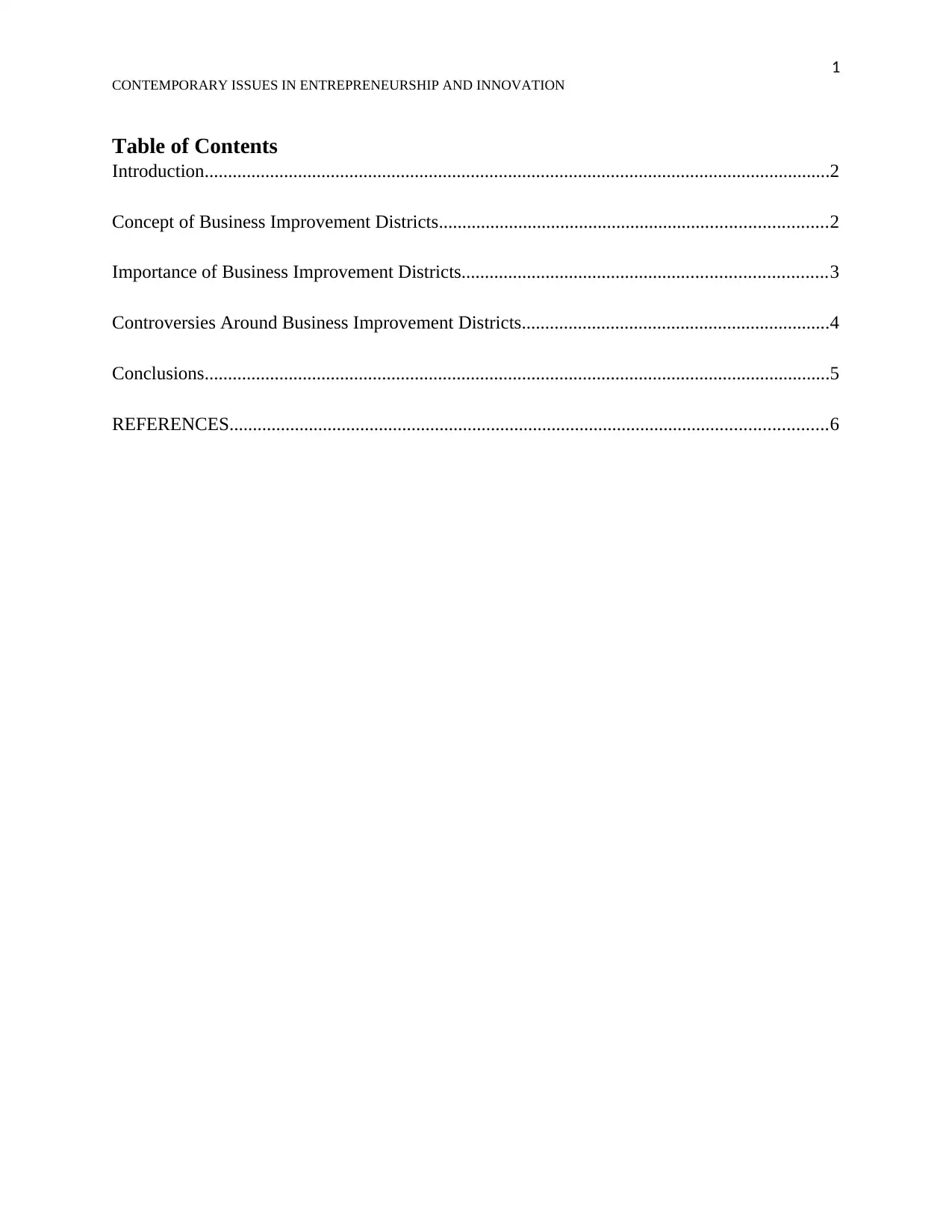
1
CONTEMPORARY ISSUES IN ENTREPRENEURSHIP AND INNOVATION
Table of Contents
Introduction......................................................................................................................................2
Concept of Business Improvement Districts...................................................................................2
Importance of Business Improvement Districts..............................................................................3
Controversies Around Business Improvement Districts..................................................................4
Conclusions......................................................................................................................................5
REFERENCES................................................................................................................................6
CONTEMPORARY ISSUES IN ENTREPRENEURSHIP AND INNOVATION
Table of Contents
Introduction......................................................................................................................................2
Concept of Business Improvement Districts...................................................................................2
Importance of Business Improvement Districts..............................................................................3
Controversies Around Business Improvement Districts..................................................................4
Conclusions......................................................................................................................................5
REFERENCES................................................................................................................................6
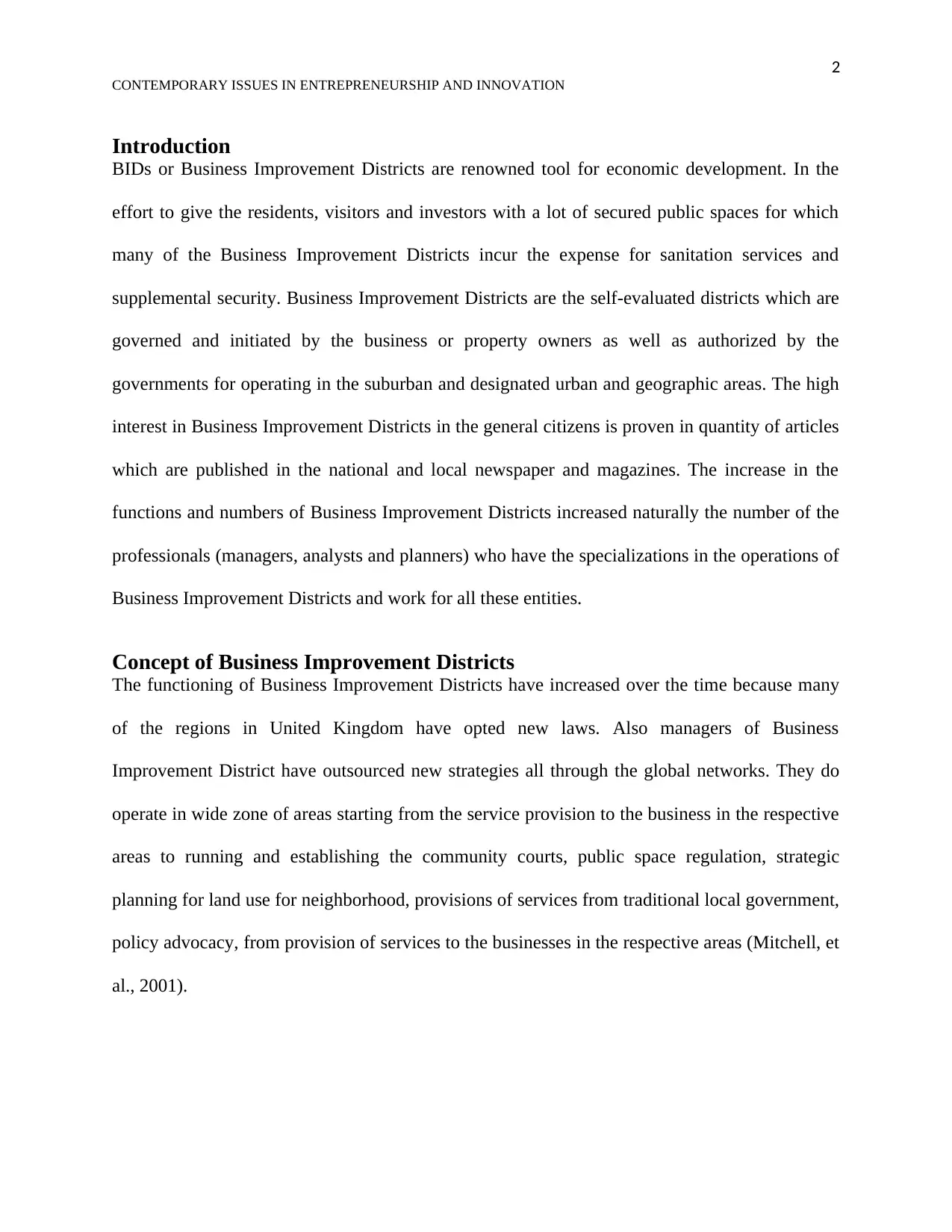
2
CONTEMPORARY ISSUES IN ENTREPRENEURSHIP AND INNOVATION
Introduction
BIDs or Business Improvement Districts are renowned tool for economic development. In the
effort to give the residents, visitors and investors with a lot of secured public spaces for which
many of the Business Improvement Districts incur the expense for sanitation services and
supplemental security. Business Improvement Districts are the self-evaluated districts which are
governed and initiated by the business or property owners as well as authorized by the
governments for operating in the suburban and designated urban and geographic areas. The high
interest in Business Improvement Districts in the general citizens is proven in quantity of articles
which are published in the national and local newspaper and magazines. The increase in the
functions and numbers of Business Improvement Districts increased naturally the number of the
professionals (managers, analysts and planners) who have the specializations in the operations of
Business Improvement Districts and work for all these entities.
Concept of Business Improvement Districts
The functioning of Business Improvement Districts have increased over the time because many
of the regions in United Kingdom have opted new laws. Also managers of Business
Improvement District have outsourced new strategies all through the global networks. They do
operate in wide zone of areas starting from the service provision to the business in the respective
areas to running and establishing the community courts, public space regulation, strategic
planning for land use for neighborhood, provisions of services from traditional local government,
policy advocacy, from provision of services to the businesses in the respective areas (Mitchell, et
al., 2001).
CONTEMPORARY ISSUES IN ENTREPRENEURSHIP AND INNOVATION
Introduction
BIDs or Business Improvement Districts are renowned tool for economic development. In the
effort to give the residents, visitors and investors with a lot of secured public spaces for which
many of the Business Improvement Districts incur the expense for sanitation services and
supplemental security. Business Improvement Districts are the self-evaluated districts which are
governed and initiated by the business or property owners as well as authorized by the
governments for operating in the suburban and designated urban and geographic areas. The high
interest in Business Improvement Districts in the general citizens is proven in quantity of articles
which are published in the national and local newspaper and magazines. The increase in the
functions and numbers of Business Improvement Districts increased naturally the number of the
professionals (managers, analysts and planners) who have the specializations in the operations of
Business Improvement Districts and work for all these entities.
Concept of Business Improvement Districts
The functioning of Business Improvement Districts have increased over the time because many
of the regions in United Kingdom have opted new laws. Also managers of Business
Improvement District have outsourced new strategies all through the global networks. They do
operate in wide zone of areas starting from the service provision to the business in the respective
areas to running and establishing the community courts, public space regulation, strategic
planning for land use for neighborhood, provisions of services from traditional local government,
policy advocacy, from provision of services to the businesses in the respective areas (Mitchell, et
al., 2001).
⊘ This is a preview!⊘
Do you want full access?
Subscribe today to unlock all pages.

Trusted by 1+ million students worldwide
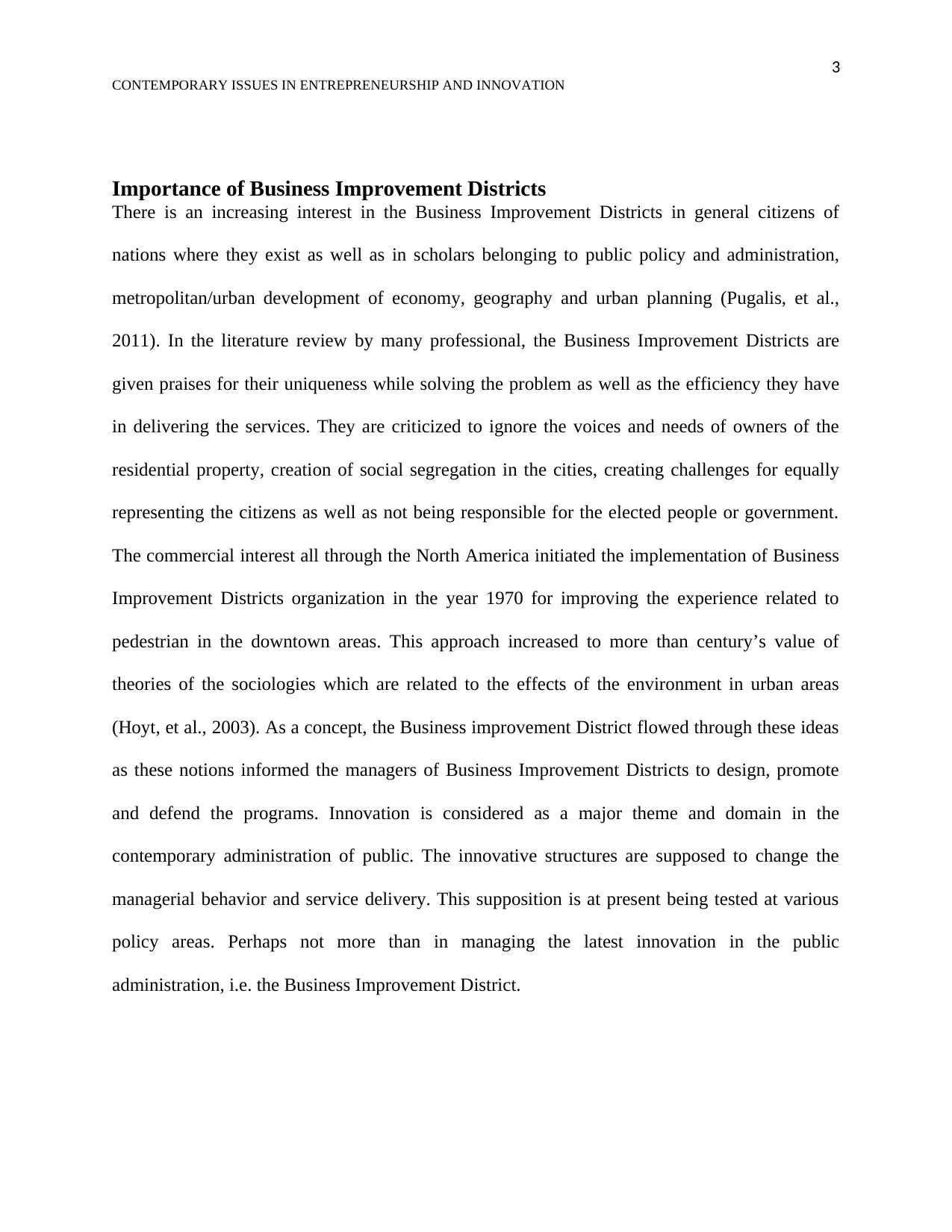
3
CONTEMPORARY ISSUES IN ENTREPRENEURSHIP AND INNOVATION
Importance of Business Improvement Districts
There is an increasing interest in the Business Improvement Districts in general citizens of
nations where they exist as well as in scholars belonging to public policy and administration,
metropolitan/urban development of economy, geography and urban planning (Pugalis, et al.,
2011). In the literature review by many professional, the Business Improvement Districts are
given praises for their uniqueness while solving the problem as well as the efficiency they have
in delivering the services. They are criticized to ignore the voices and needs of owners of the
residential property, creation of social segregation in the cities, creating challenges for equally
representing the citizens as well as not being responsible for the elected people or government.
The commercial interest all through the North America initiated the implementation of Business
Improvement Districts organization in the year 1970 for improving the experience related to
pedestrian in the downtown areas. This approach increased to more than century’s value of
theories of the sociologies which are related to the effects of the environment in urban areas
(Hoyt, et al., 2003). As a concept, the Business improvement District flowed through these ideas
as these notions informed the managers of Business Improvement Districts to design, promote
and defend the programs. Innovation is considered as a major theme and domain in the
contemporary administration of public. The innovative structures are supposed to change the
managerial behavior and service delivery. This supposition is at present being tested at various
policy areas. Perhaps not more than in managing the latest innovation in the public
administration, i.e. the Business Improvement District.
CONTEMPORARY ISSUES IN ENTREPRENEURSHIP AND INNOVATION
Importance of Business Improvement Districts
There is an increasing interest in the Business Improvement Districts in general citizens of
nations where they exist as well as in scholars belonging to public policy and administration,
metropolitan/urban development of economy, geography and urban planning (Pugalis, et al.,
2011). In the literature review by many professional, the Business Improvement Districts are
given praises for their uniqueness while solving the problem as well as the efficiency they have
in delivering the services. They are criticized to ignore the voices and needs of owners of the
residential property, creation of social segregation in the cities, creating challenges for equally
representing the citizens as well as not being responsible for the elected people or government.
The commercial interest all through the North America initiated the implementation of Business
Improvement Districts organization in the year 1970 for improving the experience related to
pedestrian in the downtown areas. This approach increased to more than century’s value of
theories of the sociologies which are related to the effects of the environment in urban areas
(Hoyt, et al., 2003). As a concept, the Business improvement District flowed through these ideas
as these notions informed the managers of Business Improvement Districts to design, promote
and defend the programs. Innovation is considered as a major theme and domain in the
contemporary administration of public. The innovative structures are supposed to change the
managerial behavior and service delivery. This supposition is at present being tested at various
policy areas. Perhaps not more than in managing the latest innovation in the public
administration, i.e. the Business Improvement District.
Paraphrase This Document
Need a fresh take? Get an instant paraphrase of this document with our AI Paraphraser
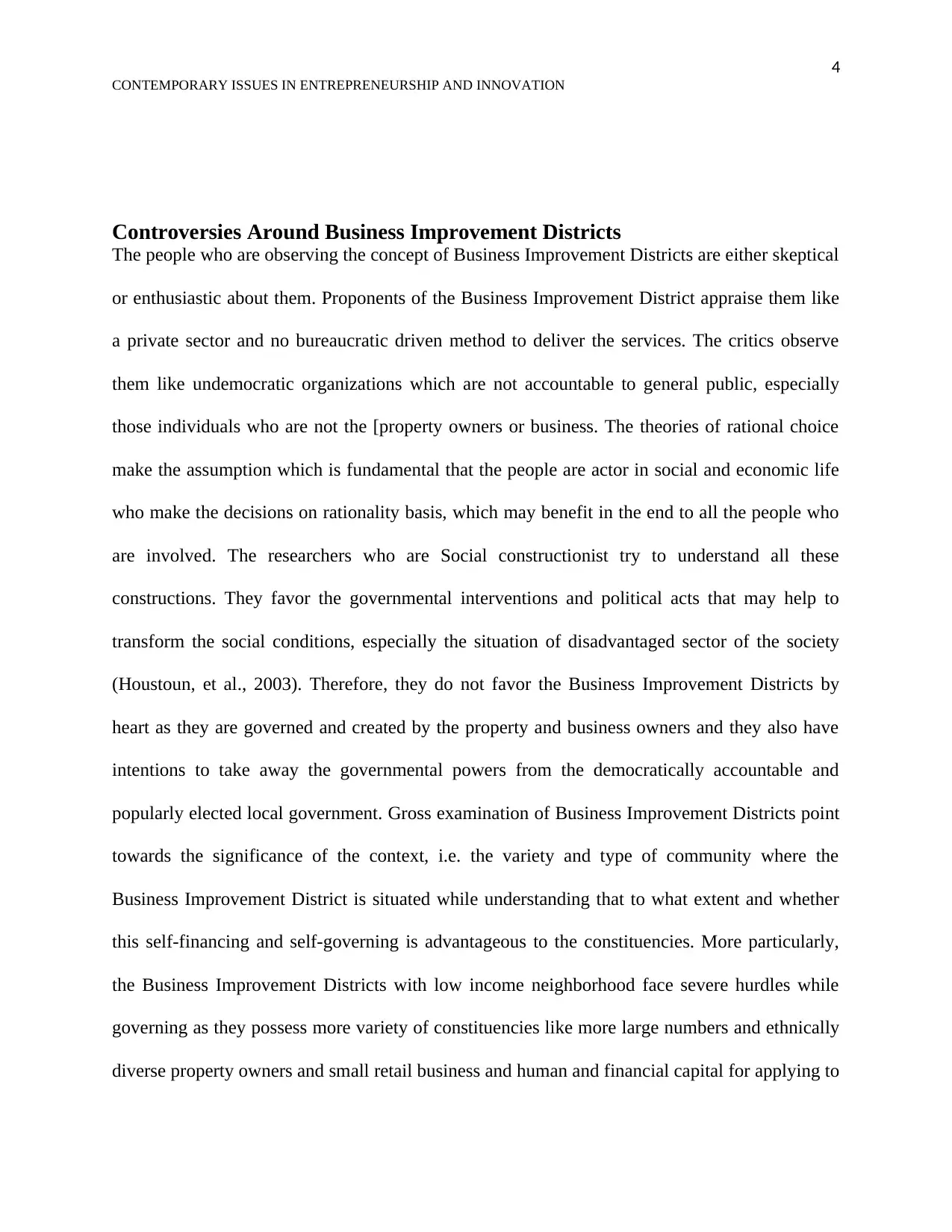
4
CONTEMPORARY ISSUES IN ENTREPRENEURSHIP AND INNOVATION
Controversies Around Business Improvement Districts
The people who are observing the concept of Business Improvement Districts are either skeptical
or enthusiastic about them. Proponents of the Business Improvement District appraise them like
a private sector and no bureaucratic driven method to deliver the services. The critics observe
them like undemocratic organizations which are not accountable to general public, especially
those individuals who are not the [property owners or business. The theories of rational choice
make the assumption which is fundamental that the people are actor in social and economic life
who make the decisions on rationality basis, which may benefit in the end to all the people who
are involved. The researchers who are Social constructionist try to understand all these
constructions. They favor the governmental interventions and political acts that may help to
transform the social conditions, especially the situation of disadvantaged sector of the society
(Houstoun, et al., 2003). Therefore, they do not favor the Business Improvement Districts by
heart as they are governed and created by the property and business owners and they also have
intentions to take away the governmental powers from the democratically accountable and
popularly elected local government. Gross examination of Business Improvement Districts point
towards the significance of the context, i.e. the variety and type of community where the
Business Improvement District is situated while understanding that to what extent and whether
this self-financing and self-governing is advantageous to the constituencies. More particularly,
the Business Improvement Districts with low income neighborhood face severe hurdles while
governing as they possess more variety of constituencies like more large numbers and ethnically
diverse property owners and small retail business and human and financial capital for applying to
CONTEMPORARY ISSUES IN ENTREPRENEURSHIP AND INNOVATION
Controversies Around Business Improvement Districts
The people who are observing the concept of Business Improvement Districts are either skeptical
or enthusiastic about them. Proponents of the Business Improvement District appraise them like
a private sector and no bureaucratic driven method to deliver the services. The critics observe
them like undemocratic organizations which are not accountable to general public, especially
those individuals who are not the [property owners or business. The theories of rational choice
make the assumption which is fundamental that the people are actor in social and economic life
who make the decisions on rationality basis, which may benefit in the end to all the people who
are involved. The researchers who are Social constructionist try to understand all these
constructions. They favor the governmental interventions and political acts that may help to
transform the social conditions, especially the situation of disadvantaged sector of the society
(Houstoun, et al., 2003). Therefore, they do not favor the Business Improvement Districts by
heart as they are governed and created by the property and business owners and they also have
intentions to take away the governmental powers from the democratically accountable and
popularly elected local government. Gross examination of Business Improvement Districts point
towards the significance of the context, i.e. the variety and type of community where the
Business Improvement District is situated while understanding that to what extent and whether
this self-financing and self-governing is advantageous to the constituencies. More particularly,
the Business Improvement Districts with low income neighborhood face severe hurdles while
governing as they possess more variety of constituencies like more large numbers and ethnically
diverse property owners and small retail business and human and financial capital for applying to

5
CONTEMPORARY ISSUES IN ENTREPRENEURSHIP AND INNOVATION
the service provisions. The Business Improvement Districts researchers and theorists agree over
the matter that Business Improvement Districts problematize the old ideas of private and public
and non-governmental and governmental Business Improvement District (Downtown, et al.,
2007).
Conclusions
The Business Improvement District give power to all the local communities but they do not
provide the power and authority to all the interest. The business Improvement Districts in
neighborhood of high income face lesser socio-economic issues, have few stakeholders as well
as greater resources which enable the increased investment in physical structure of that area. The
people in neighborhood which has low income face wide range of requirements and needs,
limited resources and wide range of stakeholders. Business Improvement Districts are the self-
evaluated districts which are governed and initiated by the business or property owners as well as
authorized by the governments for operating in the suburban and designated urban and
geographic areas.
CONTEMPORARY ISSUES IN ENTREPRENEURSHIP AND INNOVATION
the service provisions. The Business Improvement Districts researchers and theorists agree over
the matter that Business Improvement Districts problematize the old ideas of private and public
and non-governmental and governmental Business Improvement District (Downtown, et al.,
2007).
Conclusions
The Business Improvement District give power to all the local communities but they do not
provide the power and authority to all the interest. The business Improvement Districts in
neighborhood of high income face lesser socio-economic issues, have few stakeholders as well
as greater resources which enable the increased investment in physical structure of that area. The
people in neighborhood which has low income face wide range of requirements and needs,
limited resources and wide range of stakeholders. Business Improvement Districts are the self-
evaluated districts which are governed and initiated by the business or property owners as well as
authorized by the governments for operating in the suburban and designated urban and
geographic areas.
⊘ This is a preview!⊘
Do you want full access?
Subscribe today to unlock all pages.

Trusted by 1+ million students worldwide
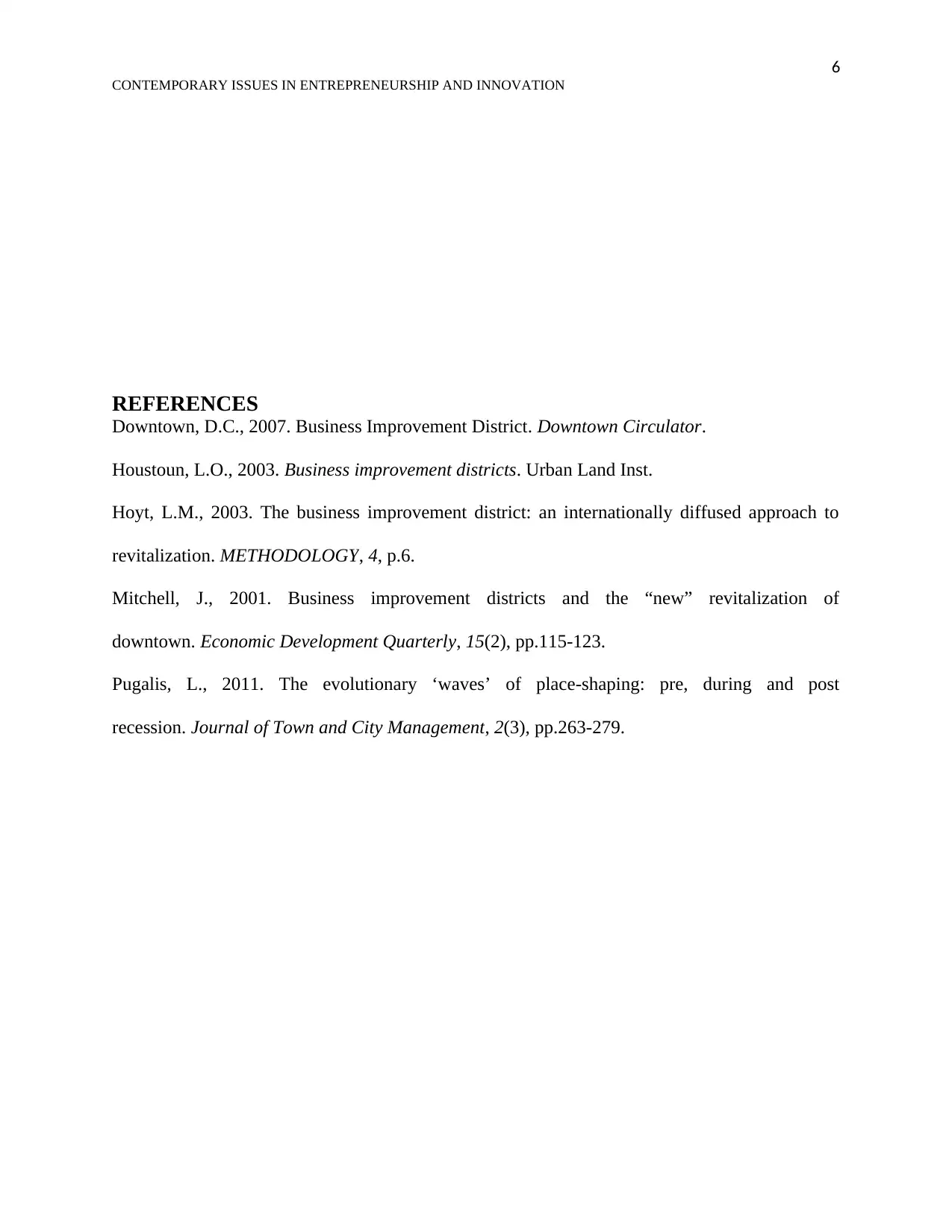
6
CONTEMPORARY ISSUES IN ENTREPRENEURSHIP AND INNOVATION
REFERENCES
Downtown, D.C., 2007. Business Improvement District. Downtown Circulator.
Houstoun, L.O., 2003. Business improvement districts. Urban Land Inst.
Hoyt, L.M., 2003. The business improvement district: an internationally diffused approach to
revitalization. METHODOLOGY, 4, p.6.
Mitchell, J., 2001. Business improvement districts and the “new” revitalization of
downtown. Economic Development Quarterly, 15(2), pp.115-123.
Pugalis, L., 2011. The evolutionary ‘waves’ of place-shaping: pre, during and post
recession. Journal of Town and City Management, 2(3), pp.263-279.
CONTEMPORARY ISSUES IN ENTREPRENEURSHIP AND INNOVATION
REFERENCES
Downtown, D.C., 2007. Business Improvement District. Downtown Circulator.
Houstoun, L.O., 2003. Business improvement districts. Urban Land Inst.
Hoyt, L.M., 2003. The business improvement district: an internationally diffused approach to
revitalization. METHODOLOGY, 4, p.6.
Mitchell, J., 2001. Business improvement districts and the “new” revitalization of
downtown. Economic Development Quarterly, 15(2), pp.115-123.
Pugalis, L., 2011. The evolutionary ‘waves’ of place-shaping: pre, during and post
recession. Journal of Town and City Management, 2(3), pp.263-279.
1 out of 7
Related Documents
Your All-in-One AI-Powered Toolkit for Academic Success.
+13062052269
info@desklib.com
Available 24*7 on WhatsApp / Email
![[object Object]](/_next/static/media/star-bottom.7253800d.svg)
Unlock your academic potential
Copyright © 2020–2025 A2Z Services. All Rights Reserved. Developed and managed by ZUCOL.





